- Home
- Garden Wildlife
- Insects
- Lepidoptera
- Stem-boring moths
Moths with stem-boring larvae
Some moths have larvae that tunnel inside the stems, trunks or branches of various woody trees, shrubs and some non-woody plants.
Species in Britain and Ireland
The moths with stem-boring larvae are in the Sesiidae and Cossidae families.
Family Sesiidae
Sixteen moths in the Sesiidae family have been recorded in Britain and Ireland. Of these, the species most likely to be seen in gardens are the currant clearwing moth, Synanthedon tipuliformis, and the apple clearwing, also known as the red-belted clearwing, Synanthedon myopaeformis, which Jennifer Owen recorded as scarce in her Leicester garden. If you are lucky you may see the nationally scarce hornet moth Sesia apiformis which is a remakable hornet mimic, with larvae feeding in the trunks of poplars.
Family Cossidae
The Cossidae has three representatives in Britain and Ireland, of which leopard moth, Zeuzera pyrina, and perhaps goat moth, Cossus cossus, may be found in gardens. At one time goat moth was regarded as a pest of fruit trees but its numbers have declined considerably and these days is mainly associated with oak and birch trees.
Double click to edit
Larva of leopard moth, Zeuzera pyrina Larva of Goat moth, Cossus cossus
Role of moths with stem-boring larvae in gardens
Stems and branches that have been tunnelled by caterpillars are weakened and may break in windy weather. The most damaging of the above stem-boring caterpillars is that of the leopard moth. Trees may be infested with no more than a single caterpillar but if that is feeding in the trunk of a sapling tree, it can cause the trunk to snap, which often requires the tree to be replaced.
Stem-boring caterpillars are commonly extracted from their feeding places and eaten by woodpeckers.
Other sources of information
Websites
Web site for moths of Butterfly Conservation
Website of UK Moths
Books
Newland, D., Still, R. & Swash, A. (2019) Britain’s Day-flying Moths. WildGuides Ltd
Porter, J. (2010) Colour Identification Guide to the Caterpillars of the British Isles. Apollo Books
Skinner, B. (2009) Colour Identification Guide to the Moths of the British Isles. Apollo Books
Townsend, M. Waring, P. and Lewington R. (2018) Concise Guide to the Moths of Great Britain and Ireland. British Wildlife Publication
Page drafted by Andrew Halstead, reviewed by Andrew Salisbury, edited by Steve Head
Currant clearwing moth, Synanthedon tipuliformis, red-belted clearwing, Synanthedon myopaeformis, and the Hornet moth Sesia apiformis
Biology and life cycle of Sesiidae
Clearwing moths are day-flying moths. Their wings are largely devoid of coloured scales, so they are mostly transparent – hence the name ‘clearwing’. Some clearwing moths have yellow or red bands across their black abdomens and could be mistaken for a solitary wasp. This is an example of Batesian mimicry in which harmless animals evolve colouration suggesting they are dangerous or taste unpleasant.
Most clearwing moths develop as larvae inside the stems of woody plants but some bore down into the stem base or roots of wild flowers, such as docks, sea thrift and bird’s foot trefoil. Currant clearwing moth larvae feed inside the stems of red and black currants, or less frequently in the stems of gooseberry. Apple clearwing larvae tunnel under the bark of apple trees.
These moths are active in mid summer, when they lay eggs on suitable host plants. After hatching, the larvae bore into the stems, trunks or branches. Clearwing moths take one year to complete their development, overwintering as larvae and pupating in late spring.
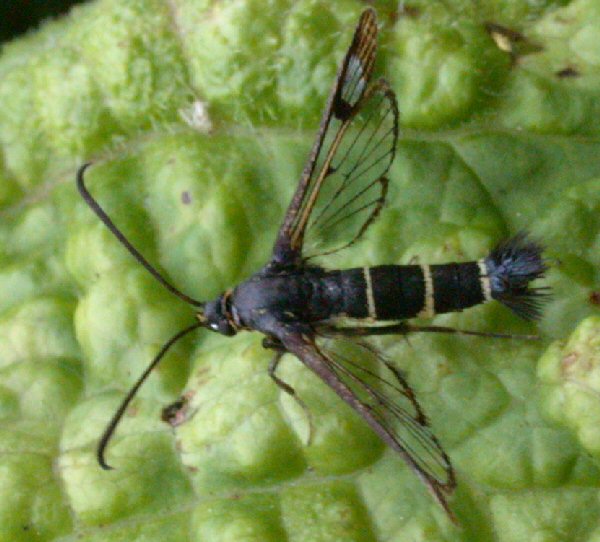
![Red-belted Clearwing Synanthedon myopaeformis O=Photo: by Neil Phillips [CC BY 2.0 (https://creativecommons.org/licenses/by/2.0)]](images/Red-belted_Clearwing_Synanthedon_myopaeformis.jpg)
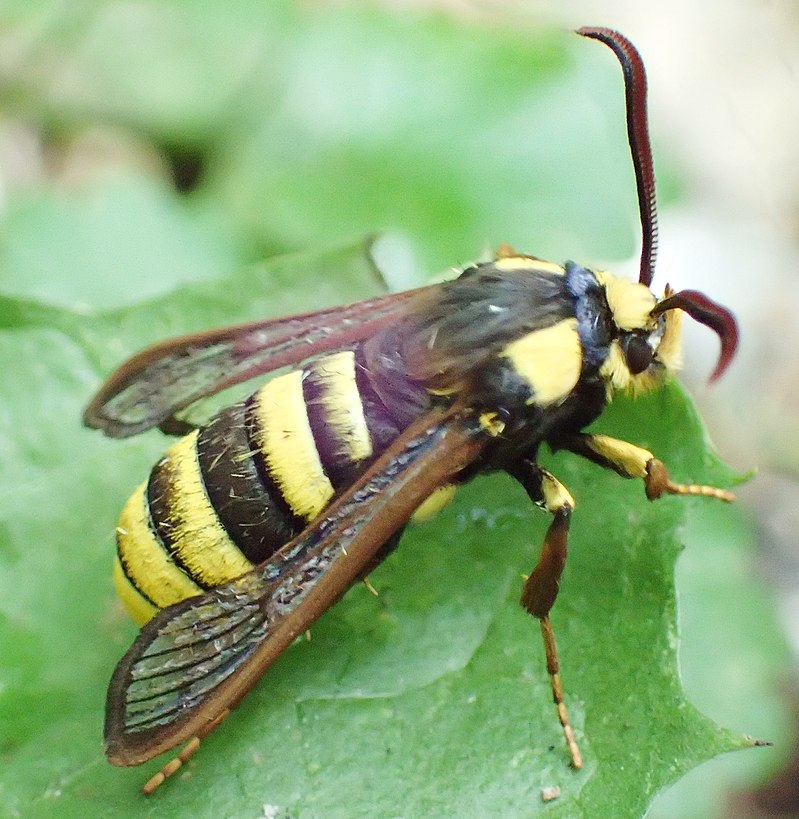
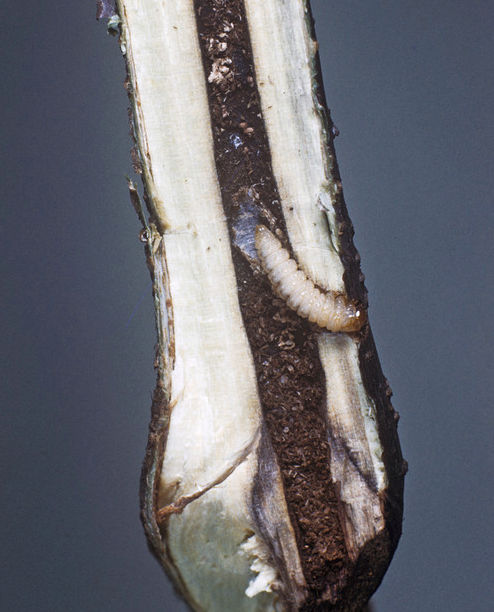
Currant clearwing moth Synanthedon tipuliformis larva within stem of Currant Ribes sp.
Leopard moth, Zeuzera pyrina Goat moth, Cossus cossus
Biology and life cycle of Cossiidae
Goat moth caterpillars are up to 100mm long when fully grown. The larvae develop in the trunk and branches of oak, birch and some other deciduous trees. The larvae have an odour similar to that of male goats. Leopard moth larvae develop in the trunks and branches of various deciduous trees and shrubs. Apple, mountain ash and other Sorbus species, birch and oak are frequent host plants. When fully grown, the caterpillars are about 50mm long. They usually feed in stems and branches with a diameter of less than 100mm.
Wood is not very nutritious, and is hard to digest, even with the help of symbiotic protozoa and bacteria. Leopard moth larvae take two or sometimes three years to complete their feeding. The first summer is spent feeding inside a thin branch, with the caterpillar later transferring to a more substantial branch or trunk. Goat moth caterpillars take even longer to complete their feeding, sometimes taking up to five years. When goat moth caterpillars are fully grown, they leave the tree in which they have been feeding. They crawl around for a while before going down into the soil where they pupate.
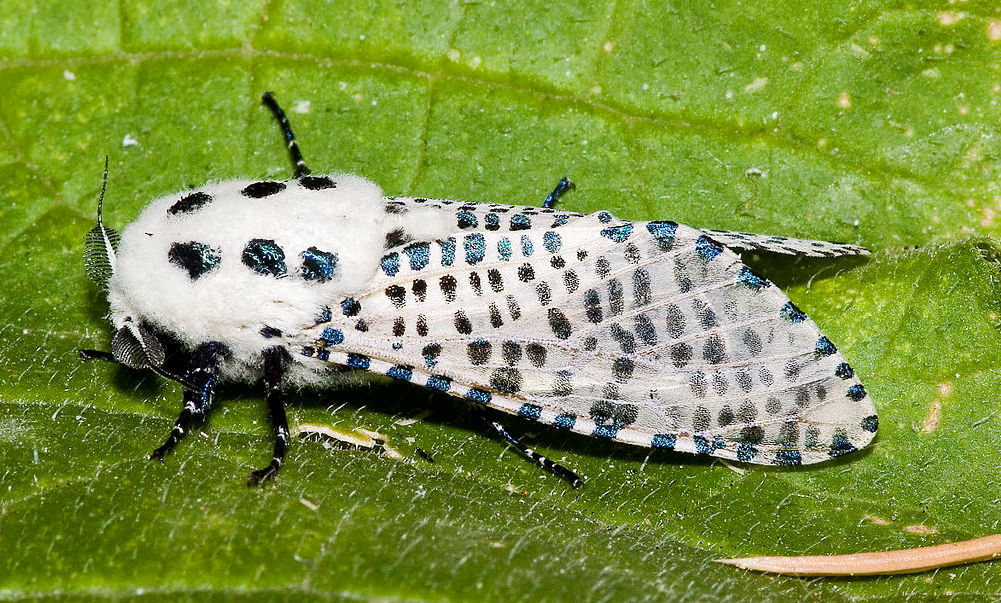
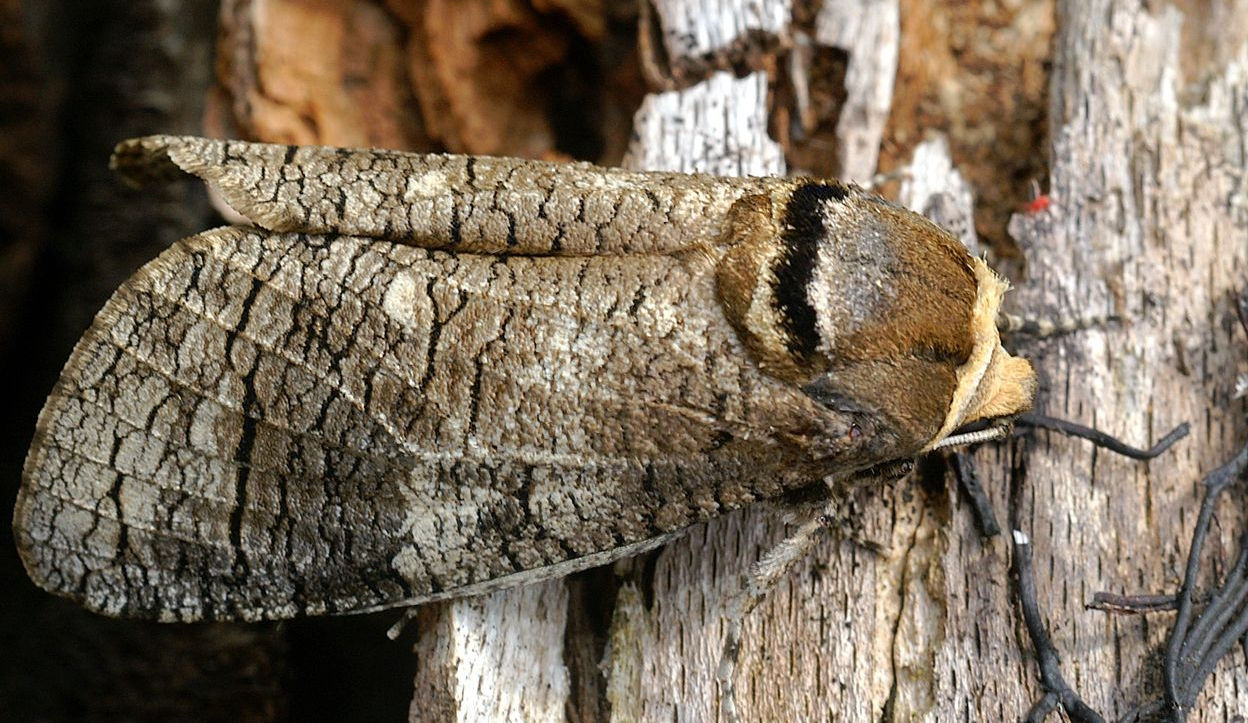
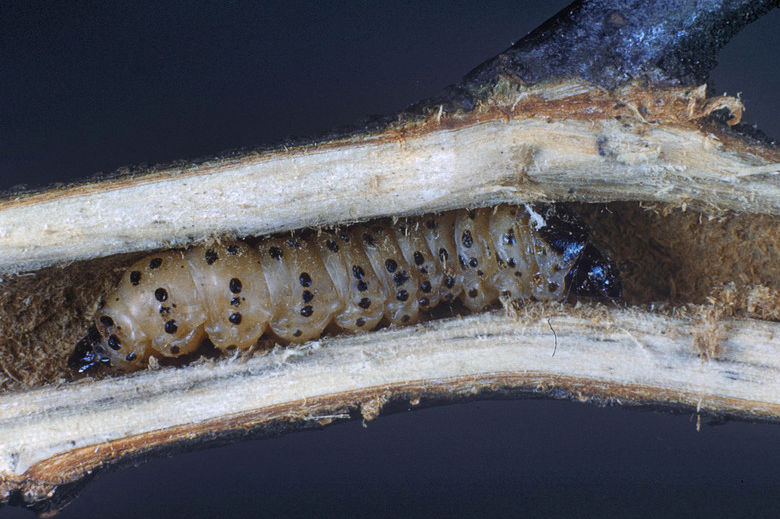
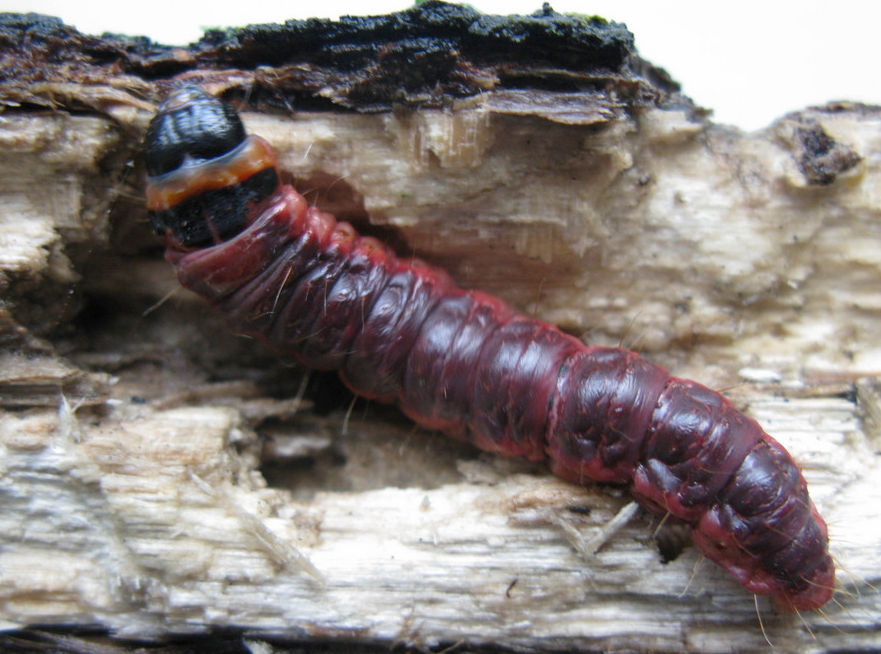
Moths with stem-boring larvae
Some moths have larvae that tunnel inside the stems, trunks or branches of various woody trees, shrubs and some non-woody plants.
Species in Britain and Ireland
The moths with stem-boring larvae are in the Sesiidae and Cossidae families.
Family Sesiidae
Sixteen moths in the Sesiidae family have been recorded in Britain and Ireland. Of these, the species most likely to be seen in gardens are the currant clearwing moth, Synanthedon tipuliformis, and the apple clearwing, also known as the red-belted clearwing, Synanthedon myopaeformis, which Jennifer Owen recorded as scarce in her Leicester garden. If you are lucky you may see the nationally scarce Hornet moth Sesia apiformis which is a remakable hornet mimic, with larvae feeding in the trunks of poplars.

![Red-belted Clearwing Synanthedon myopaeformis O=Photo: by Neil Phillips [CC BY 2.0 (https://creativecommons.org/licenses/by/2.0)]](images/Red-belted_Clearwing_Synanthedon_myopaeformis.jpg)

Currant clearwing moth, Synanthedon tipuliformis, red-belted clearwing, Synanthedon myopaeformis, and the Hornet moth Sesia apiformis
Biology and life cycle of Sesiidae
Clearwing moths are day-flying moths. Their wings are largely devoid of coloured scales, so they are mostly transparent – hence the name ‘clearwing’. Some clearwing moths have yellow or red bands across their black abdomens and could be mistaken for a solitary wasp. This is an example of Batesian mimicry in which harmless animals evolve colouration suggesting they are dangerous or taste unpleasant.
Most clearwing moths develop as larvae inside the stems of woody plants but some bore down into the stem base or roots of wild flowers, such as docks, sea thrift and bird’s foot trefoil. Currant clearwing moth larvae feed inside the stems of red and black currants, or less frequently in the stems of gooseberry. Apple clearwing larvae tunnel under the bark of apple trees.
These moths are active in mid summer, when they lay eggs on suitable host plants. After hatching, the larvae bore into the stems, trunks or branches. Clearwing moths take one year to complete their development, overwintering as larvae and pupating in late spring.

Currant clearwing moth Synanthedon tipuliformis larva within stem of Currant Ribes sp.a


Leopard moth, Zeuzera pyrina Goat moth, Cossus cossus
Biology and life cycle of Cossiidae
Goat moth caterpillars are up to 100mm long when fully grown. The larvae develop in the trunk and branches of oak, birch and some other deciduous trees. The larvae have an odour similar to that of male goats. Leopard moth larvae develop in the trunks and branches of various deciduous trees and shrubs. Apple, mountain ash and other Sorbus species, birch and oak are frequent host plants. When fully grown, the caterpillars are about 50mm long. They usually feed in stems and branches with a diameter of less than 100mm.
Wood is not very nutritious, and is hard to digest, even with the help of symbiotic protozoa and bacteria. Leopard moth larvae take two or sometimes three years to complete their feeding. The first summer is spent feeding inside a thin branch, with the caterpillar later transferring to a more substantial branch or trunk. Goat moth caterpillars take even longer to complete their feeding, sometimes taking up to five years. When goat moth caterpillars are fully grown, they leave the tree in which they have been feeding. They crawl around for a while before going down into the soil where they pupate.
Family Cossidae
The Cossidae has three representatives in Britain and Ireland, of which leopard moth, Zeuzera pyrina, and perhaps goat moth, Cossus cossus, may be found in gardens. At one time goat moth was regarded as a pest of fruit trees but its numbers have declined considerably and these days is mainly associated with oak and birch trees.


Larva of leopard moth, Zeuzera pyrina Larva of Goat moth, Cossus cossus
Role of moths with stem-boring larvae in gardens
Stems and branches that have been tunnelled by caterpillars are weakened and may break in windy weather. The most damaging of the above stem-boring caterpillars is that of the leopard moth. Trees may be infested with no more than a single caterpillar but if that is feeding in the trunk of a sapling tree, it can cause the trunk to snap, which often requires the tree to be replaced.
Stem-boring caterpillars are commonly extracted from their feeding places and eaten by woodpeckers.
Other sources of information
Websites
Web site for moths of Butterfly Conservation
Website of UK Moths
Books
Newland, D., Still, R. & Swash, A. (2019) Britain’s Day-flying Moths. WildGuides Ltd
Porter, J. (2010) Colour Identification Guide to the Caterpillars of the British Isles. Apollo Books
Skinner, B. (2009) Colour Identification Guide to the Moths of the British Isles. Apollo Books
Townsend, M. Waring, P. and Lewington R. (2018) Concise Guide to the Moths of Great Britain and Ireland. British Wildlife Publication
Page drafted by Andrew Halstead, reviewed by Andrew Salisbury, edited by Steve Head












